Securing Your Starlink in Australia's Rugged Landscape
Starlink mounting solutions are essential for maintaining a reliable satellite internet connection in Australia's diverse and often harsh environments. Whether you're in the Outback or a coastal town, finding the right mounting option can be the difference between frustrating dropouts and rock-solid connectivity.
Quick Answer: Common Starlink mounting options in Australia include:
- Roof mounts – For permanent installation on metal, tile, or Colorbond roofs
- Wall mounts – Ideal for homes with limited roof access or flat structures
- Pole mounts – Perfect for clearing obstructions like trees or buildings
- Non-penetrating mounts – For renters or temporary installations
- Vehicle/RV mounts – For mobile setups on 4WDs, caravans, or boats
- Ground stands – Simple setup for testing or temporary deployment
For many Australians in remote communities, Starlink represents more than just fast internet—it’s a critical lifeline to services, education, and work opportunities. As Rob from Western Queensland told us, "After years of struggling with patchy mobile broadband, mounting my Starlink properly on a tall pole cleared the gum trees and changed everything for our family business."
The mounting solution you choose needs to withstand Australia’s unique challenges: scorching summers, cyclonic winds in the north, salty coastal air, and everything in between. SpaceTek Australia’s custom-engineered mounts are specifically designed with these conditions in mind, using lightweight yet durable aluminium that won’t rust or deteriorate like standard steel options.
When selecting your mount, consider three key factors: your Starlink dish model (Standard, Mini, or High Performance), your installation location (roof, wall, ground, or vehicle), and your local environmental conditions. The right mount not only optimises your signal by providing a clear view of the sky but also protects your valuable equipment from damage.
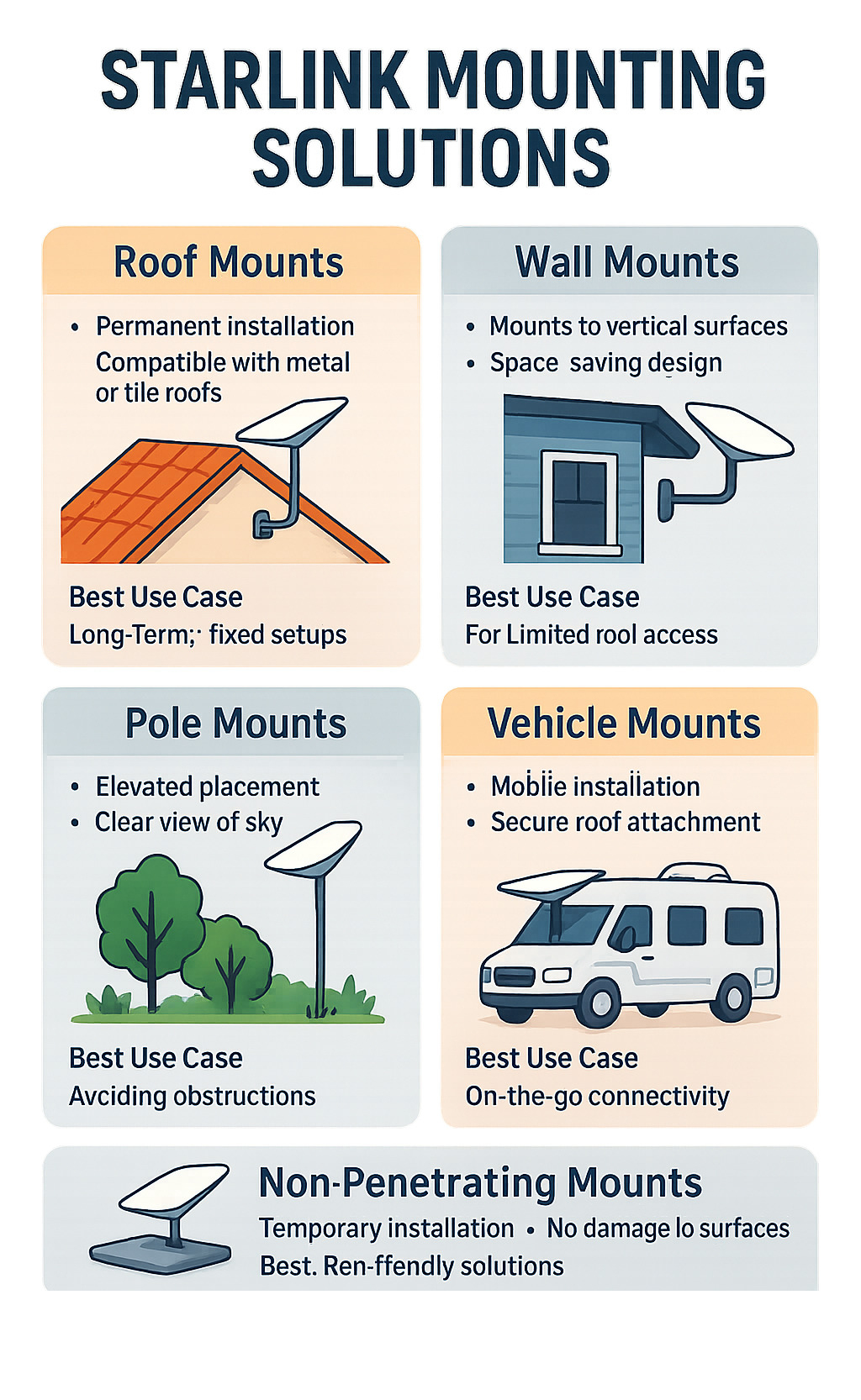
Why Mounting Matters for Remote Australia
The Australian Outback presents unique challenges for satellite internet users. When you're hundreds of kilometres from the nearest technician, a properly mounted Starlink dish isn't just convenient—it's essential for maintaining your lifeline to the outside world.
Many Starlink users find that poor signal reception often stems from mounting issues rather than service limitations. Australia's weather extremes put extraordinary demands on mounting hardware, from scorching 45°C summer days to cyclonic winds exceeding 200 km/h in northern regions. Standard mounts not designed specifically for these harsh Australian conditions can quickly deteriorate, leaving your dish misaligned and your connection unreliable.
Wind loading is particularly critical for Australian installations. Your Starlink dish essentially acts like a sail when exposed to high winds, creating significant force on mounting points. SpaceTek Australia's mounts are engineered with higher wind load ratings specifically for our unique conditions, where standard overseas mounts might fail during the first severe weather event.
The diverse range of Australian roof types presents additional challenges. Whether you have Colorbond metal roofing, terracotta tiles, or older asbestos cement sheeting, each surface requires specific mounting techniques to ensure watertight and secure installation. In bushfire zones, heat resistance and non-combustible materials become essential safety factors that can't be overlooked.
The Connectivity Gap in Regional Australia
The digital divide across our vast continent remains stark despite government initiatives. While city-dwellers enjoy multiple connectivity options, remote communities often face a limited choice between expensive, data-capped mobile broadband or nothing at all.
For Australians beyond the reach of reliable NBN, Starlink has emerged as a genuine game-changer. With download speeds regularly exceeding 100 Mbps and latency under 50ms in most parts of Australia, properly mounted Starlink systems deliver city-quality internet to even the most isolated homesteads.
Off-grid living presents additional challenges for maintaining reliable internet. SpaceTek Australia's mounting solutions are designed with these scenarios in mind, providing compatibility with solar power systems and consideration for the limited resources available to off-grid households across Remote Australia.
How Elevation Improves Throughput
One of the most overlooked aspects of Starlink performance is proper elevation. The Starlink app's obstruction scan feature provides a crucial tool for determining optimal dish placement, but many users don't fully act on its recommendations.
The science behind dish angle and elevation is straightforward: Starlink's LEO satellites move across the sky rather than remaining fixed like traditional geostationary satellites. This means your dish needs a wide, unobstructed view of the sky—ideally 100 degrees or more—to maintain consistent connectivity.
In practical terms, this often means getting your dish above surrounding obstacles. Data collected from Australian Starlink users shows that raising a dish just 1-2 metres can dramatically improve throughput in areas with partial obstructions. In heavily treed areas common throughout rural Australia, pole mounts extending 3-5 metres above rooflines have transformed marginal connections into rock-solid service.
When properly liftd and securely mounted, your Starlink dish can deliver reliable internet that closes the connectivity gap for remote communities across Australia, ensuring you stay connected regardless of your location.
Starlink Mounting Solutions for Every Scenario
The rugged Australian landscape presents unique challenges for satellite internet users. From the scorching Outback to windswept coastal properties, your Starlink dish needs a mount that can handle whatever Mother Nature throws at it. At SpaceTek Australia, we've developed mounting options specifically designed for our diverse environments and installation scenarios.
Roof & Wall Starlink Mounting Solutions
Most Aussie homeowners opt for a permanent roof mount for their Starlink dish. If you've got a Colorbond or metal roof (as many rural properties do), our custom-engineered roof mounts distribute weight properly while maintaining a watertight seal – absolutely crucial during those intense summer downpours that can appear out of nowhere.
Tile roofs require a different approach. Our specialised tile replacement mounts let you install your dish securely without cracking tiles or creating leaks. These clever mounts replace a single tile with a weatherproof flashing that accommodates the Starlink mounting pole while keeping your roof's integrity intact.
For homes with gabled roofs, our ridgeline brackets position your dish at the highest point of the house for brilliant sky visibility. These attach directly to the roof ridge, avoiding the need to penetrate roof sheets in vulnerable areas where water might pool – a common cause of leaks in Australian homes.
If roof access is tricky or you're concerned about aesthetics, our eave mounts offer a practical alternative. These brackets secure your dish just below the roofline while still providing excellent sky visibility for most installations. They're particularly popular in bushfire-prone areas where minimising roof penetrations is important for ember protection.
More info about roof vs pole mounts
Mobile & Marine Starlink Mounting Solutions
Australia's legendary caravan and 4WD culture has acceptd Starlink for bringing high-speed internet to remote camping spots. Our caravan roof mounts are specifically engineered for the vibration and movement experienced during outback travel, with reinforced mounting points and secure dish retention systems that won't let you down on corrugated roads.
For serious 4WD enthusiasts, we've developed mounting systems tough enough to handle the punishment of off-road driving. These feature improved vibration dampening and quick-release mechanisms for easy dish removal when driving through areas with low-hanging branches – a must-have feature when exploring the High Country or Northern Territory.
Boat owners face perhaps the harshest mounting environment, with constant exposure to salt spray and moisture. Our marine-grade aluminium mounts include special salt-spray resistant coatings and improved corrosion protection specifically formulated for Australian coastal conditions. As one customer from Cairns told us, "After my first mount rusted through in six months, my SpaceTek marine mount still looks brand new two years later."
For those always on the move, our in-motion brackets allow Starlink to remain connected while your vehicle or vessel is moving – perfect for grey nomads, commercial fishing operations, and remote work vehicles. These sophisticated mounting systems compensate for vehicle movement while maintaining the dish's orientation toward satellites.
Temporary & Renter-Friendly Set-ups
Not everyone can (or wants to) permanently modify their dwelling. The standard Starlink kickstand base works for ground-level testing but rarely provides optimal positioning for long-term use, especially in Australia where vegetation tends to grow quickly and create obstructions.
For renters and those seeking temporary installations, our non-penetrating mounting solutions provide stability without requiring drilling. Our weighted base systems and specialised clamps allow for secure attachment to existing structures without permanent modification – keeping your landlord happy while you enjoy high-speed connectivity.
Camping enthusiasts will appreciate our ground spike systems that offer quick setup and removal while elevating the dish above ground-level obstructions. These robust mounts drive securely into all Australian soil types from coastal sand to hard-packed clay, providing stable platforms even in the windy conditions common across our continent.
Our no-drill clamp systems have become particularly popular with renters in metropolitan areas. These ingenious mounts attach to balcony railings, fence posts, or other existing structures without leaving any trace when removed – perfect for maintaining lease agreements while enjoying high-speed connectivity in your rental property.
More info about portable mounts
Choosing the Right Mount for Your Dish Model
Starlink has evolved through several generations of hardware, each with specific mounting requirements. Selecting a mount compatible with your particular dish model is essential for proper installation and performance.
The Gen 3 Standard dish, currently shipping to most Australian customers, features an integrated mounting stud with an RJ-45 style connector. SpaceTek Australia's Gen 3 compatible mounts are specifically designed to accommodate this connection style while providing secure attachment points.
For users with the Gen 2 Actuated dish, different mounting considerations apply. These dishes feature a proprietary connector and different weight distribution, requiring mounts specifically designed for their characteristics.
The Starlink Mini, popular with travellers and those seeking portable solutions, includes both a kickstand and pipe adapter mount in the kit. SpaceTek Australia offers improved mounting options that improve on these basic solutions, providing greater stability and flexibility for Australian conditions.
High Performance dishes, designed for enterprise and high-demand users, require specialised mounting due to their increased size and weight. These robust mounts ensure the larger dish remains perfectly positioned even in adverse weather conditions.
Match Mount to Dish Generation
Mounting adapters play a crucial role when matching different generations of Starlink hardware. The evolution from proprietary connections to standardised RJ-45 cable exits means that users upgrading from older systems may need adapters to utilise existing mounting infrastructure.
The Mini pipe adapter included with Starlink Mini kits fits poles between 31 mm and 50 mm in diameter, making it compatible with many existing satellite TV mounts. However, SpaceTek Australia's improved adapters provide better security and alignment features specifically designed for Australian conditions.
For users mixing and matching equipment across generations, ensuring proper adapter compatibility prevents frustrating installation issues and potential equipment damage. SpaceTek Australia's technical support team can provide guidance on the specific adapters needed for your particular combination of hardware.
The Ultimate Guide to Starlink Gen 3 Mounting Kits
Height, Tilt & Clearance Checklist
Achieving optimal Starlink performance requires attention to several key mounting factors. Elevation targets vary depending on surrounding obstructions, but generally, higher is better for clearing trees and buildings. In heavily wooded areas common throughout regional Australia, mounting heights of 3-5 metres above rooflines have proven effective.
The Starlink dish requires approximately 100° of clear sky view to maintain consistent connectivity with passing satellites. This wide field of view often surprises new users, who may underestimate the impact of seemingly distant obstructions like tree lines or hills.
Tree clearance calculations should account for future growth—a mount that clears current foliage may become obstructed as Australian native trees grow. SpaceTek Australia recommends adding a minimum of 1-2 metres of additional height in areas with growing vegetation.
Roof pitch considerations affect both mounting technique and dish orientation. On steeply pitched Australian roofs, specialised mounts that compensate for the angle ensure the dish maintains proper orientation regardless of the underlying roof angle.
Wind zone ratings are particularly important in cyclone-prone northern Australia and coastal regions. SpaceTek Australia's mounts are categorised by wind rating, allowing customers to select appropriate hardware for their specific region's weather patterns.
Cost & Availability in 2025
As Starlink adoption continues to grow across Australia, mounting solution costs have stabilised into predictable price bands. Basic wall and roof mounts typically range from $150-$300, while more specialised solutions like tall poles or marine mounts may range from $300-$600 depending on complexity and materials.
The DIY versus installer decision affects overall costs significantly. While SpaceTek Australia's mounts are designed for straightforward installation by reasonably handy homeowners, professional installation ensures proper alignment and weatherproofing. Professional installation typically adds $300-$500 to the project cost but provides peace of mind, especially for complex roof penetrations.
Stock lead times have improved dramatically since Starlink's initial Australian rollout, with most SpaceTek Australia mounts shipping within 1-3 business days. This represents a significant improvement over the months-long waits experienced during earlier stages of Starlink deployment.
Regional shipping to remote Australian locations remains a consideration, with delivery times to very remote areas sometimes extending to 1-2 weeks. SpaceTek Australia maintains distribution centres in multiple states to minimise these delays where possible.
Installation Best Practices & Common Mistakes
Proper installation techniques are critical for long-term mounting success, particularly in Australia's harsh climate extremes. Weather sealing represents the most crucial aspect of roof and wall penetrations, with different materials suited to different applications.
Silicone sealants work well for most Australian installations but can deteriorate under intense UV exposure common in northern regions. Butyl rubber products offer superior UV resistance and flexibility, making them ideal for installations in Queensland, Northern Territory, and Western Australia.
Proper grounding is often overlooked but remains essential for system protection. Australia's frequent lightning storms make lightning arrestors a wise investment, particularly in storm-prone regions and liftd rural properties.
Cable drip-loops represent a simple but effective technique to prevent water ingress. By forming a downward loop before cable entry points, water runs away from rather than toward penetrations. This simple step prevents many common water damage issues in Australian installations.
Step-by-Step Roof Install
A proper roof installation begins with accurately marking roof studs or battens to ensure secure attachment. This is particularly important with Colorbond and other metal roofing systems common throughout Australia, where missing the supporting structure below can compromise both mounting security and roof integrity.
Pre-drilling appropriately sized holes prevents splitting and ensures proper hardware fit. For metal roofing, step drill bits prevent deformation of the sheet metal during drilling.
Applying appropriate sealant before mounting hardware prevents water ingress from day one. For Australian conditions, UV-resistant sealants rated for extreme temperature ranges provide the best long-term protection.
Properly torquing lag screws ensures they're tight enough for security without over-tightening, which can damage roofing materials or strip threads. Following manufacturer specifications for torque settings prevents these common mistakes.
Rust-proof hardware is non-negotiable in Australian installations. SpaceTek Australia uses marine-grade stainless steel for all exposed fasteners, ensuring decades of corrosion-free performance even in coastal environments.
Grounding & Lightning Protection Basics
Australian Standard AS/NZS 3000 provides clear requirements for electrical installations, including satellite systems. Proper earthing requires a dedicated earthing rod driven into the ground and connected to the mounting system with appropriate gauge copper wire.
Surge protectors for both power and data lines provide essential protection for the Starlink equipment itself. These relatively inexpensive devices can prevent costly damage during Australia's frequent electrical storms.
Copper bonding straps between mounting components ensure continuous grounding throughout the system, preventing isolated components from developing dangerous potential differences during lightning events.
While proper grounding won't guarantee protection from direct lightning strikes, it significantly reduces the risk of equipment damage from nearby strikes and induced currents—a common occurrence during Australian summer storm seasons.
Scientific research on lightning mitigation
7 Common Mounting Errors to Avoid
Loose lag screws are perhaps the most common installation error. Over time, thermal expansion and contraction work screws loose unless properly torqued and secured with lock washers or thread-locking compounds.
Undersized poles buckle or bend under wind loads, particularly in cyclone-prone regions. SpaceTek Australia recommends minimum 50mm diameter poles for standard installations, with larger diameters for tall mounts or exposed locations.
Over-tightened clamps can deform mounting components or damage dish hardware. Using torque specifications prevents this common error while ensuring adequate security.
Ignored obstruction scans lead to poor performance despite proper physical installation. The Starlink app's obstruction scanning tool should guide final positioning decisions.
Unsealed cable entry points inevitably lead to water damage. Every penetration requires appropriate weatherproofing with grommets, sealants, and proper flashing techniques.
Mismatched adapters between dish generations and mounting hardware create frustrating installation problems and potential equipment damage. Ensuring compatibility before purchase prevents these issues.
Skipping app calibration after installation prevents optimal dish positioning. The Starlink system requires proper software-based orientation to maximise satellite connectivity.
Protecting Cables, Roof & Electronics Year-Round
Long-term system protection requires attention to detail beyond the initial installation. UV-rated cable sheaths prevent the degradation common in Australia's high-UV environment, where standard cables can deteriorate within months of exposure.
Cable clips secure wiring against wind damage while preventing chafing against roof edges or other abrasive surfaces. SpaceTek Australia recommends clips every 30-50cm along exposed runs for maximum protection.
Proper roof flashing techniques appropriate to the specific roofing material prevent water ingress. For Colorbond and other metal roofing, special flashing collars designed for the specific profile ensure water runs off rather than under the flashing.
Weatherproof grommets at all penetration points provide an additional layer of protection against water entry. These simple components significantly extend the life of cable runs and prevent costly water damage to both the cable and the structure.
Mesh Wi-Fi placement considerations affect overall system performance. Properly routing cables to optimal router locations throughout the home maximises coverage while protecting equipment from environmental factors.
Smart Cable Routing for Aussie Homes
Australian home construction presents unique cable routing challenges. For weatherboard walls, specialised drill guides prevent splitting while ensuring clean, properly angled penetrations that shed water away from the entry point.
Masonry kits designed for brick and concrete construction include specialised drill bits and anchoring systems that maintain structural integrity while providing secure cable pathways. These kits are essential for the brick veneer construction common throughout Australian suburbs.
Under-eave entry represents one of the cleanest installation approaches for many Australian homes. By routing cables through eave soffits, installers can avoid direct roof penetrations while maintaining a professional appearance and excellent weather protection.
Maintenance in Harsh Environments
Australia's diverse climate zones create unique maintenance challenges. In cyclone-prone northern regions, seasonal checks before the wet season ensure mounting hardware remains tight and correctly aligned. SpaceTek Australia recommends complete system inspections at least annually in these high-risk areas.
Red-dust intrusion affects installations throughout central Australia, where fine particulate can infiltrate connections and degrade performance over time. Regular cleaning with compressed air helps prevent this common issue.
Salt air corrosion threatens coastal installations, where even stainless steel can deteriorate without proper protection. SpaceTek Australia's marine-grade hardware includes additional protective coatings specifically designed for coastal environments.
Seasonal checks should include visual inspection of all mounting points, cable runs, and weatherproofing elements. Addressing minor issues before they develop into major problems extends system life and maintains performance.
Dish covers provide additional protection in extreme environments, particularly against hail damage in storm-prone regions. While the Starlink dish is designed to withstand normal weather, the added protection from impact-resistant covers prevents damage during Australia's sometimes violent summer storms.
Frequently Asked Questions about Starlink Mounts
How high should I mount my dish for the best speeds?
When it comes to mounting height, there's no one-size-fits-all answer for Aussie Starlink users. The perfect height depends entirely on your specific location and what's around you.
As a general rule, your Starlink dish needs a clear view of the sky in all directions, with minimal obstructions above about 25 degrees from the horizon. Think of your dish as needing to "see" the satellites passing overhead - anything blocking that view will impact your connection.
For those lucky enough to have properties in flat, open areas with no nearby trees or buildings, a standard roof mount that positions your dish 1-2 metres above the roofline is typically sufficient. However, if you're surrounded by gum trees or other obstacles (as many rural Australians are), you might need poles extending 3-5 metres above your roof for proper clearance.
Your best mate in determining the right height is actually the Starlink app's obstruction viewer. This clever feature uses your phone's camera to visualise potential obstructions and show how they might affect your service. If the app shows significant red areas indicating obstructions, going higher will almost certainly improve your performance.
What's the safest way to run Starlink cables into a brick wall?
Brick walls present a unique challenge when installing Starlink in Australian homes. Whether you're dealing with double-brick construction common in older Perth homes or brick veneer typical throughout suburban Melbourne, the right approach makes all the difference for a professional, weatherproof installation.
The safest and most effective method involves several key steps to protect both your equipment and your home:
Start with a proper masonry kit. SpaceTek Australia's masonry routing kits include the correct drill bits and anchoring hardware specifically designed for Australian brick and concrete walls, making the job significantly easier and more professional.
Always drill at a downward angle from outside to inside. This simple technique ensures water naturally runs away from rather than into the penetration - a crucial consideration during our sometimes torrential summer storms.
Don't skip installing a proper grommet. Quality rubber grommets prevent cable abrasion against rough brick edges while simultaneously providing an essential weather seal. This small component makes a massive difference in long-term installation quality.
Apply appropriate sealant around the entry point. Exterior-grade silicone sealant creates a weatherproof barrier that prevents moisture ingress - particularly important in high-rainfall areas like northern Queensland or Tasmania.
Always create a drip loop before the cable enters your wall. By forming the cable into a downward loop outside, you prevent water from following the cable into the wall, even during heavy rainfall.
For double-brick walls common in older Australian homes, particularly in Perth and Adelaide, specialised long-drill techniques may be required to penetrate both layers cleanly. In these cases, professional installation is often the safest approach to avoid damaging the structural integrity of your walls.
Taking these extra steps during installation will save you significant headaches down the track, ensuring your Starlink connection remains reliable regardless of what our unpredictable Australian weather throws at it.
Starlink Accessories Built for Remote Australia
When you're living in the far reaches of the Australian outback or along our rugged coastlines, your internet equipment needs to be as tough as you are. That's why we've dedicated ourselves at SpaceTek Australia to crafting Starlink accessories that can handle everything from tropical downpours in Far North Queensland to scorching summer heat in the Pilbara.
Our mounting solutions start with a fundamental difference – rust-proof aluminium construction rather than standard steel. This isn't just a minor upgrade; it's essential for Australian conditions where coastal salt spray or wet season humidity would turn ordinary steel mounts into rusty eyesores within months. Our aluminium components will still look and perform brilliantly years after installation, no matter how harsh your local climate.
The precision engineering behind our custom machined mounts ensures your Starlink dish sits exactly where it needs to be, with perfect alignment that prevents the subtle vibrations and movements that degrade performance over time. This attention to detail makes all the difference during those blustery days when cyclonic winds in the north or southerly blasters down in Tasmania put your setup to the test.
We back our products with genuine Australian warranty protection, giving you peace of mind that you're covered by local support if anything goes wrong. No complicated international warranty claims or endless email chains with overseas suppliers – just straightforward Aussie service when you need it.
As we move deeper into 2025, we're continuing to expand our range with innovative mounting solutions that address the evolving needs of Starlink users across Australia. Our engineering team works directly with customers from Broome to Birdsville, identifying the real-world challenges that remote users face and developing practical solutions that work in the real Australia – not just in a laboratory.
Our comprehensive range covers every installation scenario you might encounter, from simple roof mounts for suburban homes to specialised setups for off-grid stations hundreds of kilometres from the nearest town. Each product features improved UV protection (essential under our harsh Australian sun), superior corrosion resistance for coastal areas, and wind loading capacity that exceeds standard international products.
Explore our Starlink generations & accessories
Rugged Accessories for Tough Australian Conditions
The Australian outback throws everything it's got at your equipment - scorching heat, driving rain, howling winds, and that relentless UV exposure that breaks down materials faster than you can say "fair dinkum." That's where Starlink mounting solutions from SpaceTek Australia make all the difference.
We've spent years understanding the unique challenges Aussies face with satellite internet. A mount that works perfectly well in Europe or North America often fails spectacularly when faced with our harsh climate. It's why we've developed mounting systems specifically engineered for Australian conditions - from the cyclone-prone Top End to the salt-spray battered coastlines.
Our commitment goes beyond just selling hardware. When you choose SpaceTek Australia, you're getting mounting solutions developed by people who understand the difference between a Perth summer and a Tasmanian winter. Our engineering team has obsessed over every detail - from the grade of aluminium that resists our unique environmental challenges to the precise specifications of weatherproofing needed for tropical downpours.
For families in remote communities, reliable internet isn't just about Netflix. It's about telehealth appointments when the nearest doctor is hundreds of kilometres away. It's about children accessing educational resources. It's about maintaining business connections despite physical isolation. A properly mounted Starlink dish ensures these vital connections remain stable through dust storms, heat waves, and tropical downpours.
The Starlink revolution has transformed connectivity across Australia's vast distances, bringing city-speed internet to places that previously relied on painfully slow alternatives. SpaceTek Australia is proud to support this technological leap with mounting solutions that ensure your dish stays perfectly positioned year after year.
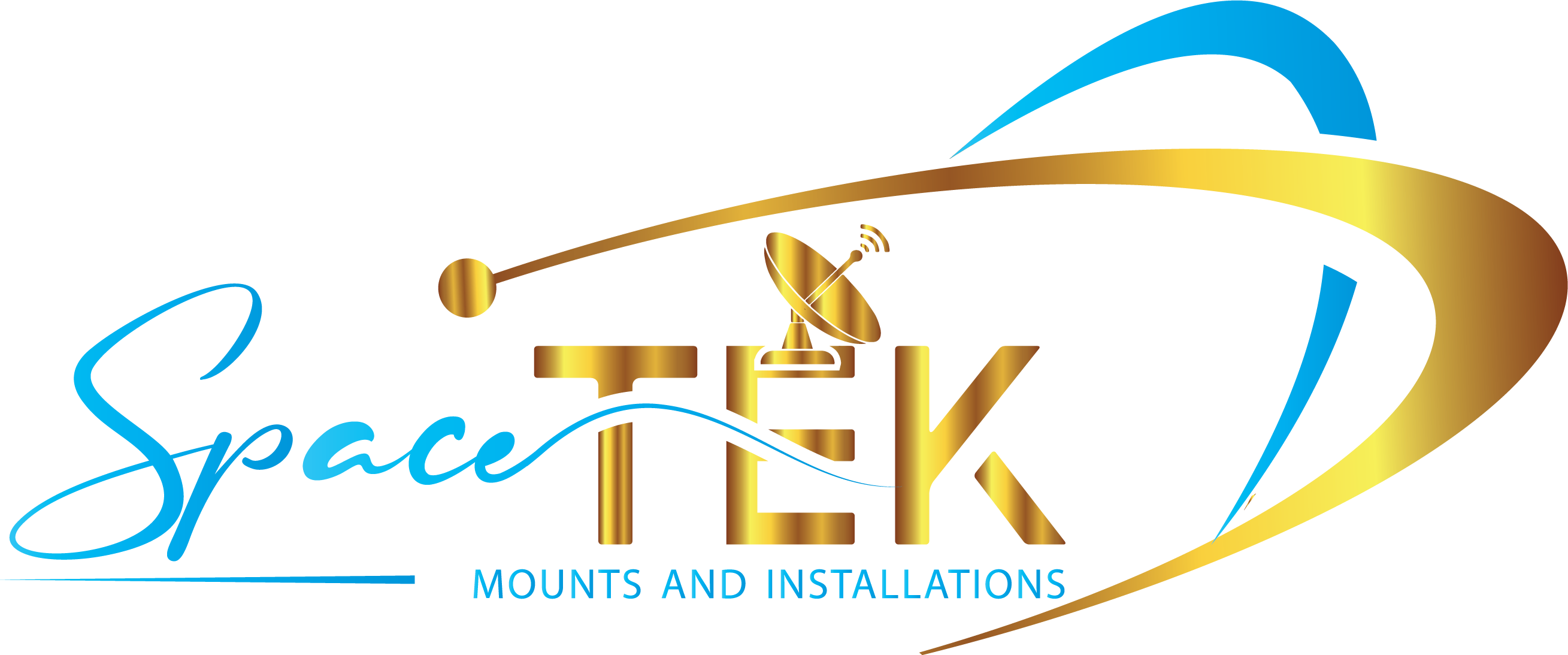
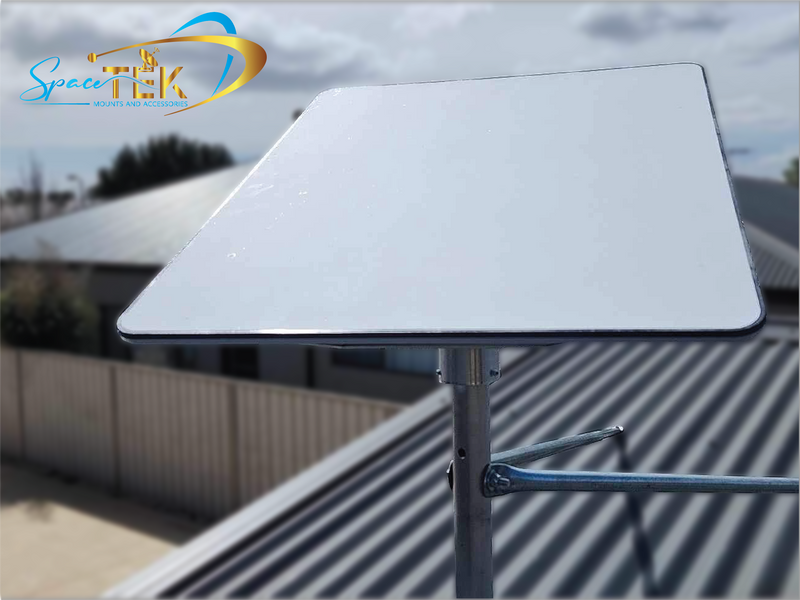
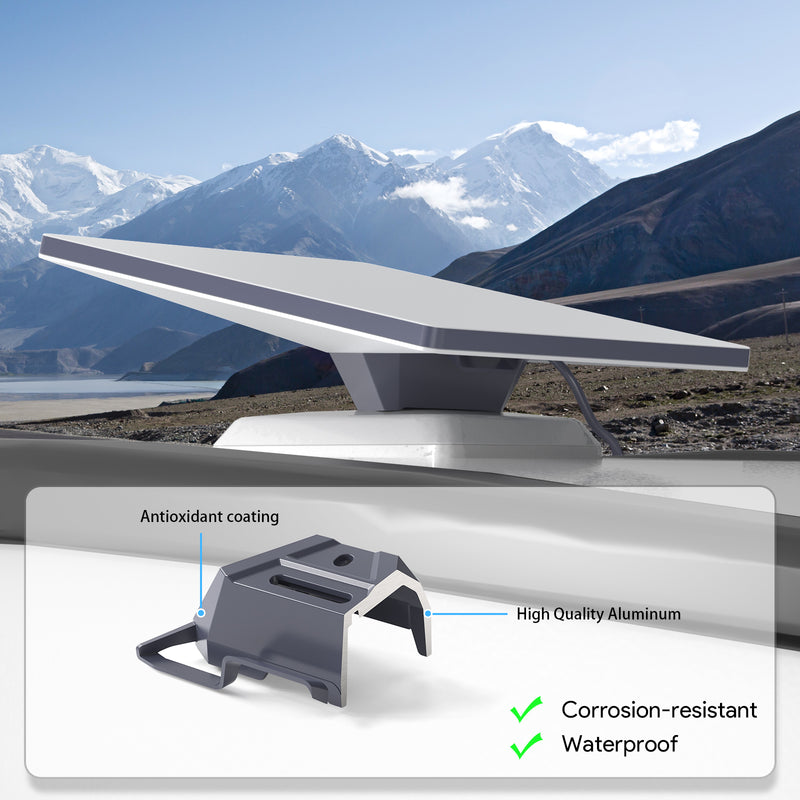
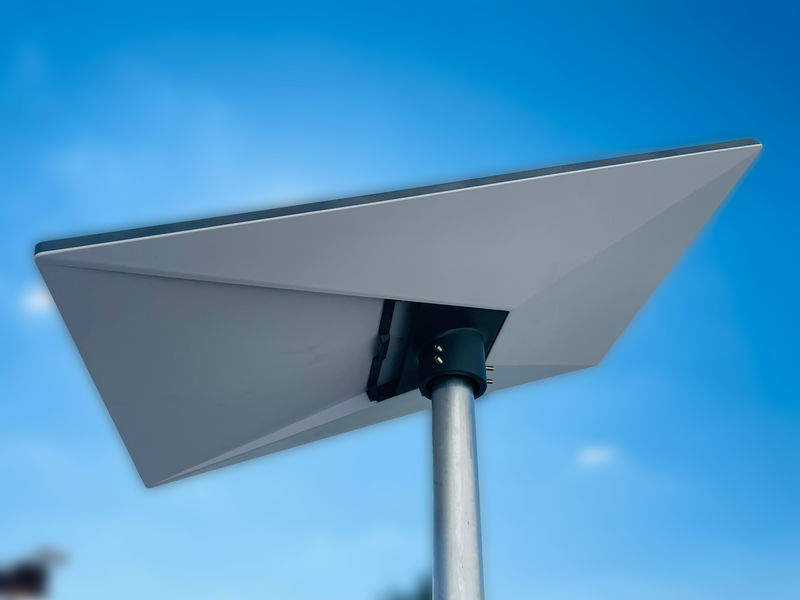
Leave a comment
This site is protected by hCaptcha and the hCaptcha Privacy Policy and Terms of Service apply.